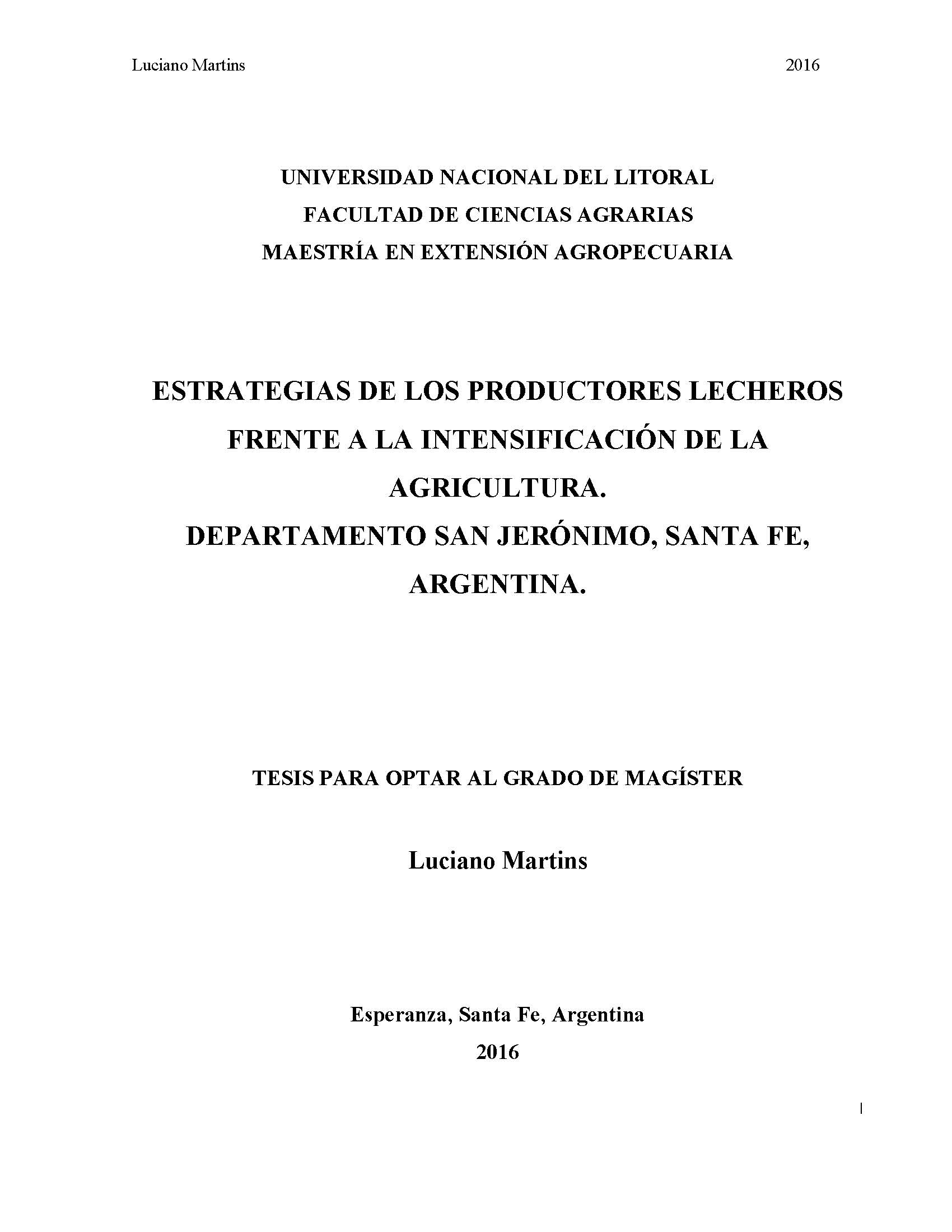Ver ítem
- xmlui.general.dspace_homeCentros Regionales y EEAsCentro Regional Santa FeEEA RafaelaTesisxmlui.ArtifactBrowser.ItemViewer.trail
Estrategias de los productores lecheros frente a la intensificación de la agricultura. Departamento San Jerónimo, Santa Fe, Argentina = Strategies for dairy farmers face of agriculture strengthening. Department San Jerónimo, province of Santa Fe, Argentina Republic
Resumen
En el departamento San Jerónimo (Provincia de Santa Fe, Argentina), a mediados del siglo XX, la
producción lechera comenzó a tener relevancia en el sector agropecuario. En el año 1970, existían
aproximadamente 700 tambos, pero en el inicio del siglo XXI el número de tambos cayó abruptamente
(145, en 2012). Este remanente de tambos es heterogéneo según, la intensidad en el uso del capital, de la
tierra y del trabajo.
Esta investigación corresponde a
[ver mas...]
En el departamento San Jerónimo (Provincia de Santa Fe, Argentina), a mediados del siglo XX, la
producción lechera comenzó a tener relevancia en el sector agropecuario. En el año 1970, existían
aproximadamente 700 tambos, pero en el inicio del siglo XXI el número de tambos cayó abruptamente
(145, en 2012). Este remanente de tambos es heterogéneo según, la intensidad en el uso del capital, de la
tierra y del trabajo.
Esta investigación corresponde a un estudio de caso con construcción de tipologías de acuerdo con un
enfoque cualitativo, en el que se identificaron y describieron las estrategias generadas por los productores
lecheros durante el período 1990-2014. Dichas estrategias les permitieron consolidar su sistema
productivo particular, adaptarse y permanecer en la producción láctea, en un contexto de cambio del sector
agropecuario y en competencia con un proceso de intensificación de la agricultura.
Se clasificaron a los productores lecheros en tres tipos teóricos y posteriormente al trabajo de campo, se
elaboraron los tipos construidos. Las principales diferencias entre éstos, se dieron por el nivel de
capacitación, información y socialización del productor.
[Cerrar]
In the mid-twentieth century, the area of San Jerónimo Department (Santa Fe province, Argentina), milk production began to have relevance in the agricultural and livestock sector. By the year of 1970, there were approximately 700 dairy farms, but in the beginning of XXI century the number of dairy farms fell sharply (145 in 2012). This remnant of dairy farms is heterogeneous according to the intensity of use of capital, land and labor. This research
[ver mas...]
In the mid-twentieth century, the area of San Jerónimo Department (Santa Fe province, Argentina), milk production began to have relevance in the agricultural and livestock sector. By the year of 1970, there were approximately 700 dairy farms, but in the beginning of XXI century the number of dairy farms fell sharply (145 in 2012). This remnant of dairy farms is heterogeneous according to the intensity of use of capital, land and labor. This research corresponds to a Study Case with typologies construction, according to a qualitative approach, in which they are identified and described generated strategies by dairy farmers during the period 1990-2014. These strategies allowed them to consolidate their particular production system, allowed them adapt and stay in the dairy production, in a context of change in the agricultural sector and in competition with an agricultural intensification process.
Were classified in three theoretical types of dairy farmers and after fieldwork, the constructed types were elaborated. The main differences between them, gave by the farmer level of Training, Information and Socialization.
[Cerrar]

Autor
Director de Tesis
Descripción
Tesis de maestría para obtener el grado de Magíster en Extensión Agropecuaria presentada en la Universidad Nacional del Litoral, Facultad de Ciencias Agrarias en 2016
Fecha
2016
Editorial
Facultad de Ciencias Agrarias, Universidad Nacional del Litoral
Formato
pdf
Tipo de documento
tesis de maestría
Palabras Claves
Derechos de acceso
Abierto
 Excepto donde se diga explicitamente, este item se publica bajo la siguiente descripción: Creative Commons Attribution-NonCommercial-ShareAlike 2.5 Unported (CC BY-NC-SA 2.5)
Excepto donde se diga explicitamente, este item se publica bajo la siguiente descripción: Creative Commons Attribution-NonCommercial-ShareAlike 2.5 Unported (CC BY-NC-SA 2.5)


